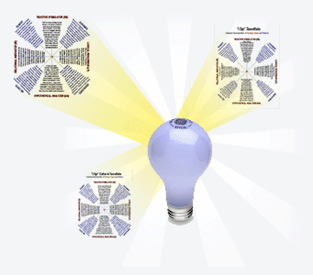Knowledge you can build upon
Research

The Institute periodically sponsors research into actual field data to which it has access. The research ranges broadly on topics of current or historical interest in Organizational Development (OD ). "I Opt" data and Organizational Engineering (OE) generated hypothesis typically form the basis of the research.
The research typically follows accepted academic standards in terms of the statistical methodology employed. However, it usually does not follow the academic writing standards of comprehensive citation of all work in an area. Rather, only publications actually referenced (if any) in the conduct of research are cited. This decision is intended to make the research more accessible and relevant to actual implementation at the cost of lessening its contribution to future, additional research.
- How To Optimize The Kolb Learning Model
- This research is based on 185 adult classes conducted by 4 organizations. A total of 3,116 students participated. The research shows that a 60-40 allocation among Kolb learning stages will improve learning performance for the population as a whole. A 70-30 allocation among learning styles is also indicated for the 3,116 population. The research goes on to show that there is a marked variation in individual classes and that an instructional design strategy based on the median (midpoint) of the targeted population is optimal.
- Read More
- Experimental Movie
 This is an experimental movie developed using Google's Sketchup technology and is designed to make statistics
more accessible to a general audience. The content is actual data of 366 individuals who participated in adult
learning classes at a major corporation in 2006. The movie is video only.
This is an experimental movie developed using Google's Sketchup technology and is designed to make statistics
more accessible to a general audience. The content is actual data of 366 individuals who participated in adult
learning classes at a major corporation in 2006. The movie is video only. - Read More
- Structural Barries to Change and Innovation in Nursing
 This is a summary of research by Bea Kalisch, Titus Professor
of Nursing at the University of Michigan that was published in
the juried journal NAQ. The study was done using a total of 578
nurses in two geographically separated hospitals. Professor
Kalisch identified a number of statistically significant factors
that directly address why change and innovation are difficult to
realize in nursing. She contrasted nurses with scientists,
engineers and corporate managers and found systematic
differences. Finally, she isolated leadership divergences that compound the challenges faced by hospitals in meeting evolving healthcare demands in a fast changing environment..
This is a summary of research by Bea Kalisch, Titus Professor
of Nursing at the University of Michigan that was published in
the juried journal NAQ. The study was done using a total of 578
nurses in two geographically separated hospitals. Professor
Kalisch identified a number of statistically significant factors
that directly address why change and innovation are difficult to
realize in nursing. She contrasted nurses with scientists,
engineers and corporate managers and found systematic
differences. Finally, she isolated leadership divergences that compound the challenges faced by hospitals in meeting evolving healthcare demands in a fast changing environment.. - Read More
- Human Resources VP’s "Seat at the Table"CEO
- The "I Opt" data for 233 Vice Presidents were categorized by function. The Vice Presidents of Human Resources were then compared to the VPs of other function. The purpose of the research was to see if there were any statistically significant differences that might account for HR's lack of regular participation in corporate-wide strategy and policy decision forums. The research discovered a statistically significant discrepency (p<.05) that can account for the difficulty HR has in earning a "seat at the table."
- Read More
- CEO Insights
- Ninety eight (98) CEOs from both profit and non-profit sectors were researched. The research showed that all CEOs shared a family resemblance. However, non-profit and profit sector CEOs showed a systematic difference in the way they approached issues. In addition, it was found that CEOs of large firms tended to have more inclination toward ideas while those of bantum size firms tend to be more inclined toward action.
- Read More
- Gender Related Strategic Style Differences
- Three hundred Corporate Level VP's and 1,429 Managers/Directors were divided by gender and compared. The research found that males and females are literally (not just virtually) identical in the information processing (i.e., strategic style) approach that they apply in addressing corporate issues.
- Read More
- Information Processing Styles of Nurses and Nurse Managers
- by: Beatrice Kalisch, Titus Distinguished Professor of Nursing, University of Michigan.
- This PowerPoint presentation outlines Dr. Kalisch's groundbreaking study of nurses in two major medical institutions. She finds systematic differences within the medical profession (e.g., RN, LPN, NA, etc.) as well as between nurses and other non-medical areas. Her findings isolate the causes of some of the major problems currently confronting the nursing profession. Dr. Kalisch offers both recommendations for immediate action and directions for future research.
- Read More
- "I Opt" Validity: Validation Explained in English
- This article explains what validation is and why it is important in language that is understandable to everyone. All eight dimensions of validity (content, face, construct, convergent, discriminant, concurrent, predictive and conclusion) as well as reliability are treated.
- Read More
- Leadership Development
- Dr. Ashley Field's doctoral dissertation research is updated and extended. Dr. Fields conclusions on strategic styles are found to hold when applied to a larger sample of 919 teams. The research was then extended to include strategic patterns in addition to styles. The results suggest that leadership development must be approached as a staged process rather than as a universal "one size fits all" approach.
- Read More
- Consultant Profile: Getting the Gig
- Research on 185 external and 67 internal consultants was conducted. Internal and external consultants were similar except that internal consultants were more committed to disciplined methods (input) and thought mode (output). Consultants are shown to be markedly different from the general population (n=24,765). They also differ systematically from various levels in the corporate hierarchy and most closely approximate the CEO in their information processing approach.
- Read More